Next up in our look back at the playoffs is the second round series between the Nashville Predators and the San Jose Sharks. Out of all the matchups, this is the one I was looking forward to tracking the most. Both teams are among my favorites in the league to watch and their seven-game playoff series didn’t disappoint one bit. This series went back-and-forth and home ice seemed to dictate who had the advantage, with San Jose ultimately coming out on top in a 5-0 blowout in Game 7.
Going into the series, I thought both teams were good enough to win their conference. San Jose had a great season and just made quick work of the Los Angeles Kings while Nashville just knocked off the top-seeded Anaheim Duck in seven games. Nashville might have been a Wild Card team, but they quietly had a very good season and were a top-three team in controlling territorial play. A sub-par season from Pekka Rinne was a big reason why they ended up lower in the standings than they should have been and they matched up pretty well with San Jose from a stats point of view, ranking two spots above them in Score Adjusted Fenwick.
On the surface, this series was pretty uneven in the sense that it kept going back-and-forth and the advantage seemed to shift to whoever had home ice. San Jose appeared to have the upper-hand the entire way, though. After all, they never fell behind in this series, led the Preds in every game and it took Nashville a couple of overtime wins to tie the series and force a Game 7. Still, Nashville gave them quite a scare and they were one game away from pulling off another huge upset. What made this a tight series and what led to the Sharks coming out on top?
5v5 Shot Attempts
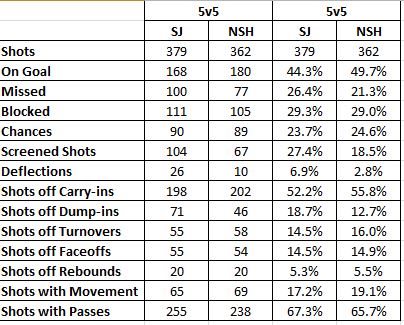
Shot Locations
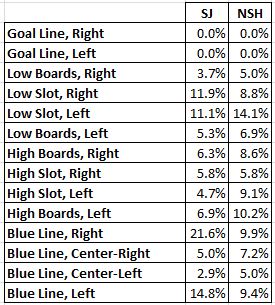
The stats reflect the results of this series pretty well, as both teams ended up being very close with San Jose having a slight edge in just about every category. The only categories where San Jose had the major edge on Nashville were related to net-front presence (screen shots & deflections), which makes sense when you take each team’s playing styles into account. San Jose shot from the point a lot this series (more on that later) and getting deflections in the slot or in front of the net was a big part of their game plan in the offensive zone (hi Pavelski!). Nashville, on the other hand, created most of their offense off the rush or by forcing turnovers.
San Jose also created most of their offense on the rush, but they were more likely to work the puck back to the point than Nashville was and they were adamant about trying to make Rinne’s job as difficult as possible when they took shots from long range. Thus, they ended up having way more screened shots and deflections than the Predators. This isn’t to say that the Preds did a bad job of getting to the net, as they actually did a pretty good job of creating shots in dangerous areas. This was just a bigger part of San Jose’s game plan. More of Nashville’s low-percentage shots came from bad angles along the boards, and they usually resorted to these when there wasn’t any other option.
That said, San Jose also did a very good job of working the puck into dangerous areas, whether it was through deflections or passing plays into the slot, they gave Nashville’s strong defense a run for their money this series and got to them in a few different ways. Nice transition into our look at each team’s tactics in the neutral zone.
5v5 Zone Entries

The neutral zone stats tell an interesting story because overall, Nashville had the advantage here. They had the puck more, carried the puck into the zone on a higher percentage of their entries and forced the Sharks to dump the puck in quite a bit. Nashville won the battle in the neutral zone, but San Jose still outshot them on entries despite this, granted by only a small amount. Not only that, but the Sharks also outscored the Preds by four goals, so the Preds winning the battle in the neutral zone didn’t result in much. It’s pretty surprising because the team that won the neutral zone battle usually went on to at least have the advantage in terms of shots in every series we’ve looked at so far. Not so much the case here. It’s also surprising when you look back at the previous chart and see the percentage of shots San Jose created off entries done with control of the puck.
The one area where San Jose had the edge on Nashville was that they were generating way more shots when they could carry the puck in. Normally, we expect teams to create twice as many shots off entries where they have control of the puck as opposed to dump-ins, San Jose almost three times as many. Dumping the puck in was a big part of their game plan, but all they were really doing then was wearing down Nashville’s defense or draining the clock. They did most of their damage when they could get space in the neutral zone and cross the blue line with speed and support. Even if you concede that the Sharks have more high-end talent than the Predators, it’s bizarre to see a team outshoot their opponents this much on controlled entries, especially when you consider that Nashville was able to carry the puck in on a higher percentage of their entries.
You may have noticed that I added a new category that shows how often each team was able to carry the puck in the zone with a teammate driving the center lane. Since this was a huge part of Pittsburgh’s success in the Washington series, I started tracking that for this series to see how much of an impact it had on shot generation. You can see that San Jose had a guy driving the center lane on over 78% of their entries compared to only 71.2% for Nashville. Did this impact the results at all?
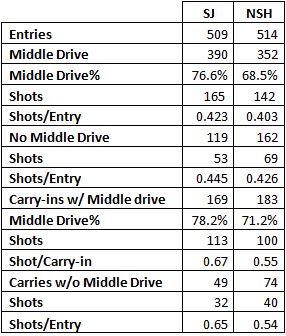
Short answer: no. San Jose shad a middle driver on a higher percentage of their entries than Nashville but it didn’t make much of a difference in terms of shot generation. In fact, both teams created more shots on entries where there wasn’t a middle driver, which is weird and goes against my theory, but we’re not working with a small sample here. Both teams created more shots on carry-ins with a middle driver as opposed to when they did not, but it wasn’t a huge difference at all. So, San Jose’s play in the offensive zone was probably a bigger key to their success rather than their neutral zone tactics. We’re going to dive into each team’s individual numbers to get a closer look at this.
San Jose Sharks
5v5 Zone Entries
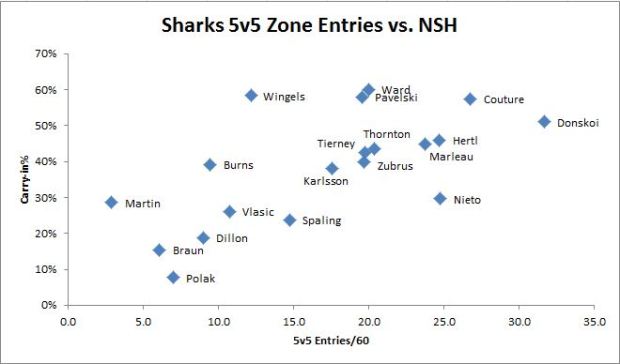
5v5 Shot Attempts & Passes

Normally, I have zone entries and shot generation in separate categories but we’re going to tie the two together here for this series because there’s some interesting things to point out in regards to San Jose’s strategy. First, let’s get an overview of the zone entry graph since that’s where the offense starts. You’ll notice that San Jose had a select few forwards who carried the puck in on a high percentage of their entries while most of the group dumped the puck in about 54-60% of the time with the exception of Matt Nieto & Nick Spaling who find themselves in Dump Truck Territory. Most of the Sharks defense can be found in this part of the graph, too except for Brent Burns, who was given a little more freedom with the puck in the neutral zone.
Either way, you can see that most of the Sharks played dump-and-chase, including two-thirds of their top line. Two players that didn’t were Logan Couture & Joonas Donskoi, who were among their best offensive players at even strength. In fact, these two along with Patrick Marleau (and Joel Ward for the first three games) drove most of San Jose’s offense at five-on-five when you take everything into consideration. They were their two best players at carrying the puck in, had a huge role in the neutral zone and were two of San Jose’s best passers. Donskoi had more of a designated role as a play-maker while Couture made his mark as a dual-threat, doing a little of everything. Arguably the Sharks best player at five-on-five this series.
Outside of Couture, most of the Sharks shooters are defensemen. You go down the list of San Jose’s leaders in Shot Attempts per 60 and it’s basically their entire defense corps. This goes back to what we touched on earlier with how generating shots from the point was a focal point of San Jose’s game plan. It also reveals why San Jose created such a high number of shots off carry-ins. They carried the puck into the zone, try to make a play with it, got to the rebound, worked the puck back to the point, took another shot and repeated the process as many times necessary. Their strategy was pretty easy to pick up on, especially in Game 5, a game in which they dominated.

Here we see the Sharks starting a normal looking breakout with Justin Braun doing the honors. Nashville is making a change, so the breakout is a little easier for them to accomplish and they were able to carry the puck in pretty easily.
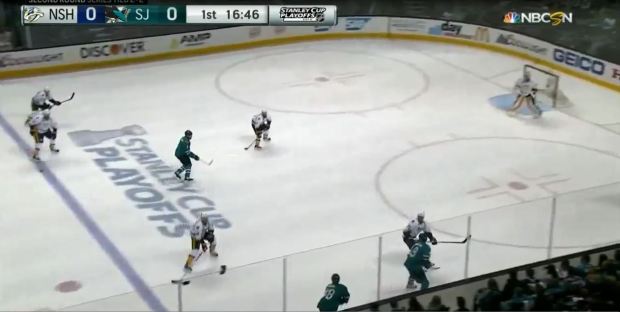
As expected, San Jose gets the puck into the zone with control with Tomas Hertl having support nearby in the form of Joe Thornton and Joe Pavelski driving the center lane. Despite being late on a change, Nashville doesn’t appear in too bad of shape here, as the Sharks have the puck on the boards.

Hertl and Thornton play a quick game of give-and-go and Hertl eventually tries to cut to the middle of the ice with the puck, getting around defenseman Mattias Ekholm in the process. He also has Pavelski occupying the far-side defenseman (Ryan Ellis) and creating some space in front of the net.
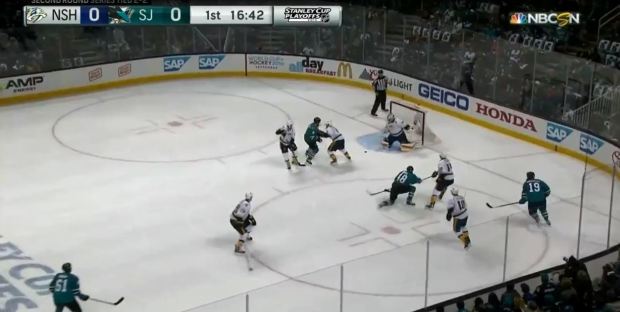
Hertl fights off the defenseman and gets a decent scoring chance on goal. Rinne gives up a rebound but Ellis has good position on Pavelski, so Nashville avoids the danger for now. This is just Phase 1 of San Jose’s attack, though. It would have been nice of Hertl scored, but they have back-up plans.
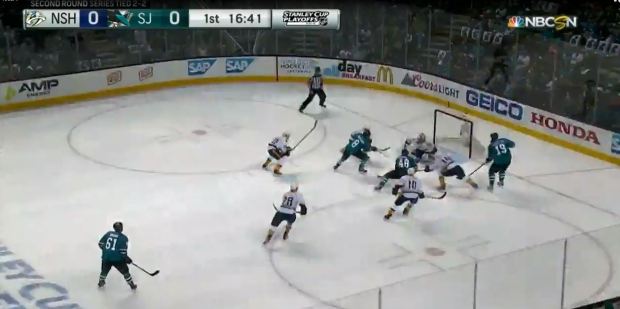
There’s a battle for the loose puck in front of the goal and the Predators are able to get to it first and clear it to the side of the ice.
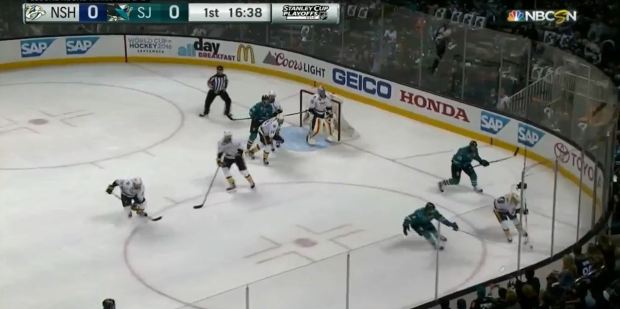
Nashville gets possession after clearing the rebound and Mikka Salomaki is ready to start the breakout. Or at least that’s what he would do if there weren’t two Sharks players surrounding him. Both Thornton and Pavelski immediately swarmed on him the second he touched the puck. Salomaki has nowhere to go and the only thing he can do with the puck is clear it and hope it at least gets to the neutral zone where a teammate can recover it. Meanwhile, Hertl goes to Pavelski’s spot in front of the net in case the Sharks get possession.

Salomaki gets help from a couple of his teammates, but it’s too late and Pavelski has already forced a turnover/bad clear.
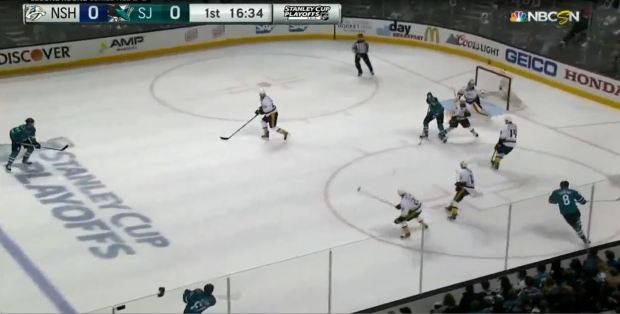
The puck eventually goes back to the point where the San Jose defenseman (Braun) wastes no time to fire a shot at the goal. Keep in mind he has Hertl in position for a deflection so Rinne has to do a little work if this does find its way on goal.
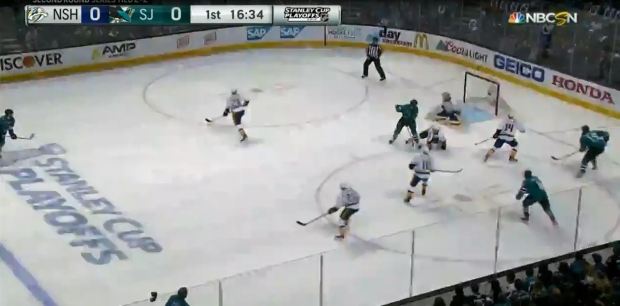
Hertl tries for a deflection and Rinne reacts as if there is one, but the shot ultimately misses the goal and the rebound goes around the boards.
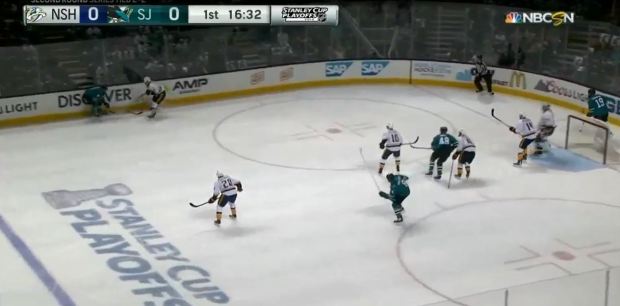
San Jose tries to keep the play alive with Vlasic pinching in from the point (presumably to ring the puck to Thornton or back to Vlasic), but Nashville forward Paul Gaustad is there to meet him and he is able to clear the puck out of the zone.
This play ended up being fairly harmless for Nashville even though the Sharks created a pretty good scoring chance off the rush, but you can see pretty clearly what San Jose was trying to do, especially with their first line. Pavelski led the team in deflected shots while Hert led the team in screens. Factor this in with Thornton leading the Sharks in Primary Shot Assists by a pretty wide margin and it’s easy to sort out what each player’s role is. Pavelski & Hertl were also among the top Sharks forwards in Shots Attempts per 60 minutes, so they had roles as shooters, especially on the rush. However, they were still behind the defense, showing that the blue line was the Sharks primary shooting option.
They consistently went back to plays like the one diagramed above in Game 5 and it eventually paid off after a little patience.
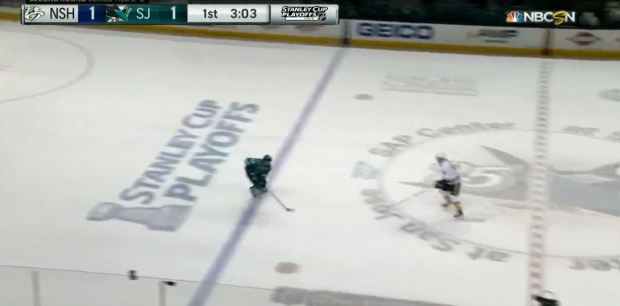
This play starts with Hertl skating the puck out of the zone with one Nashville player to beat in center ice.
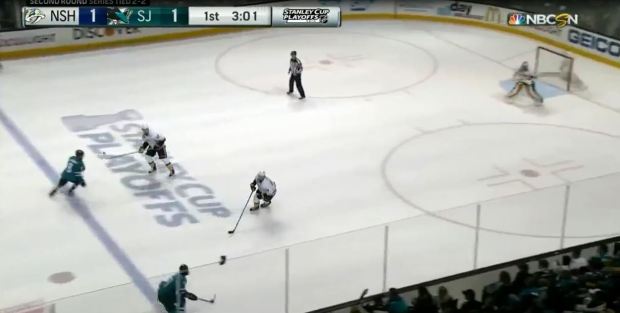
He gets by the forechecker pretty quickly and the Sharks get to work with a two-on-two rush in which they have a forward (Ryan Johansen) playing defense. Hertl, however, enters the zone against Roman Josi and he is given a pretty big cushion by the Nashville defenseman. Presumably he’s playing a little more conservative since he has a guy not in his natural position as his defense partner for this particular rush.
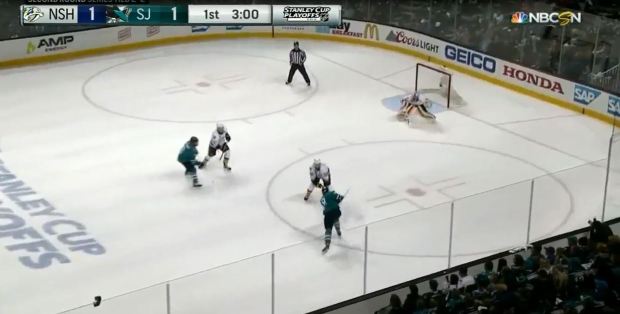
Hertl wastes no time to take his shot and it’s not a very good one. Josi might have backed off at the blue line but he didn’t give Hertl much space to work with and the Shark forward was pretty quick to get a shot away.
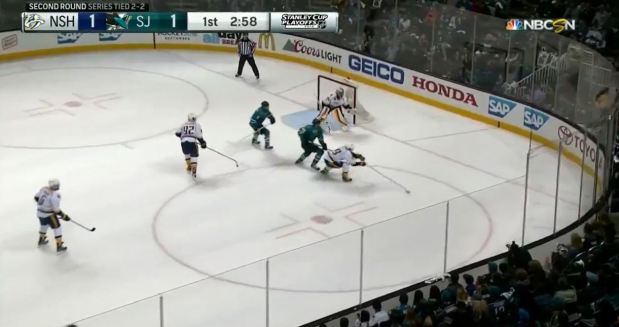
As you probably guessed, Josi blocks the shot and it goes to the corner.…
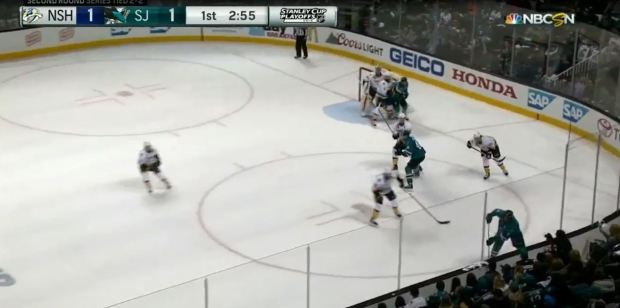
Josi has a bit of a stinger from blocking Hertl’s shot and Thornton is able to beat him to the puck. You can see where he is going with it and San Jose’s other two forwards are beginning to setup in their proper positions.

Burns receives Thornton’s pass and he immediately fires the puck towards Hertl in the slot. You can see that Nashville left the points wide open and the forward in the center of the picture’s first reaction is to get there as fast as possible to try and block the shot. Unfortunately for him, it’s too late and Burns isn’t trying to shoot the puck. He’s trying to get it to the guy Nashville left wide open in a prime spot for a deflection.
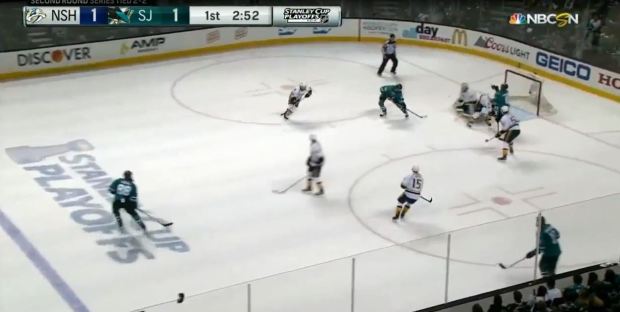
Hertl is able to get his stick on the puck but the deflection ends up missing the net ricochets around the boards.
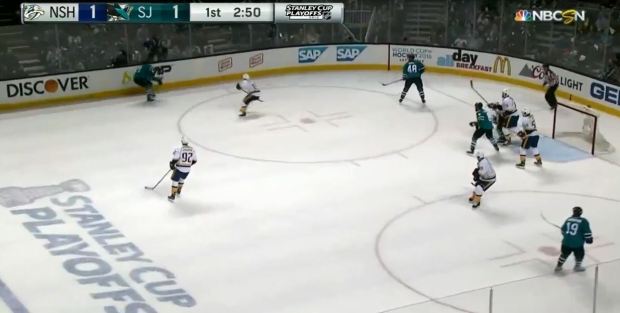
With all the attention going to Hertl, Nashville doesn’t have a winger covering the right wing to clear the puck like last time, so the left defenseman is able to keep the play alive and ring the puck around the boards to the last person the Preds want with the puck right now.
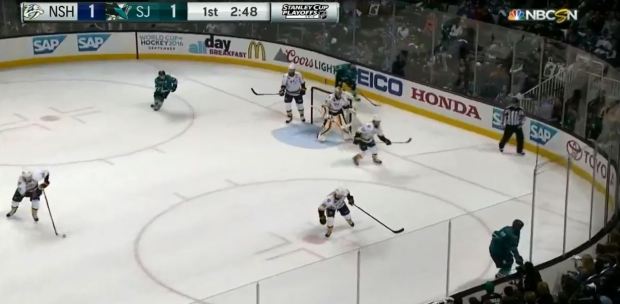
Thornton gets the puck again and this time the Preds seem to know where things are going. You can see they have one forward high in the picture going to the point. The only problem is that the play happened so fast and everyone is still trying to get back into position, so no one is pressuring Thornton and he is able to get the puck back to the point pretty easily.
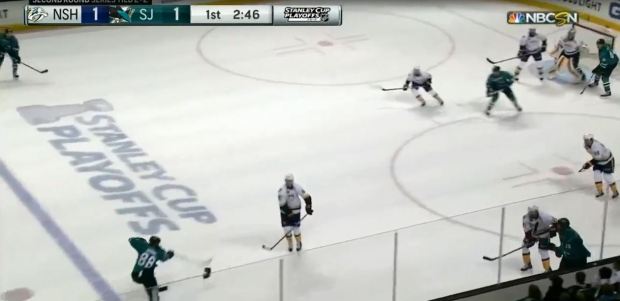
Thornton sets up Burns at the point and once again, gets the puck towards the net with a player (PavelskI) in the slot and Hertl camped out at the side of the net if there’s a rebound. Nashville’s in a little better position here since they’re actually covering the point, but no one was quick enough to cover Pavelski in the slot, so he can get a deflection if he’s quick enough.

The deflection try comes up short as Burns misses Pavelski’s stick by a few feet, possibly forced by Nashville putting more pressure on the right point and not giving him much time to get a shot away. That said, Burns avoided the shot getting blocked and the right wing is open yet again, so San Jose can start the process over again.

You know where this is going.

Thornton has to do a little more work to get the puck this time around, as Nashville knows what’s coming and puts two players on him. They also have a forward going out the point to intercept or block Burns from getting a shot away. There’s another situation developing, though. With Nashville trying to double team Thornton AND give extra attention to Burns, there’s an odd-man situation in front of the net with Pavelski & Hertl.
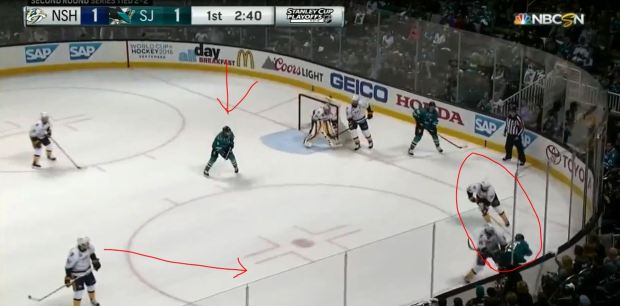
Nashville tries to diffuse the situation by pressuring Thornton as much as possible before he can do anything with the puck. Weber notices that Pavelski is wide open and tries to at least front the shot before Thornton can get him the puck. Nashville has enough players around Thornton that this hopefully won’t be a problem for them.

Thornton connects on a pass that only he and a few others can make, setting up Pavelski before anyone on the Preds can get a stick on the puck to break up the play.
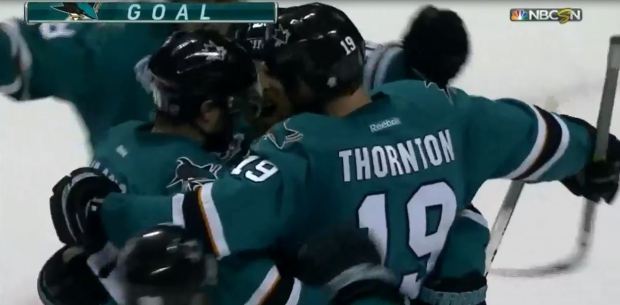
The Sharks score and everyone is happy. The whole sequence was a pretty interesting case of both teams adjusting to each other’s strategies on the fly. Nashville picked up on San Jose’s main strategy of working the puck back to the point and Thornton made a heads-up play to get around this. Shows how much of a chess match this series was and how much both teams had to work to get an advantage. Having an elite talent like Thornton on your roster also helps.
Nashville Predators
5v5 Zone Entries

5v5 Shot Attempts & Passes

With how dominant San Jose was to close things out, it’s easy to forget that Nashville had a very good series and gave the Sharks a run for their money. The fact that they forced seven games wasn’t a fluke and their own play in the neutral zone gave San Jose some fits. They weren’t generating as many shots off carry-ins, but they still created most of their shots this way and had a higher percentage of controlled entries than San Jose. This was led by their top-six, all of whom carried the puck in on more than 50% of their entries and specifically the line of James Neal, Mike Fisher and Colin Wilson.
These three were put together in Game 3 and were easily the team’s best line in the neutral zone with Wilson in particular having a fantastic series. He had the biggest role as the line’s puck-carrier in the neutral zone and shined as a play-maker in the offensive zone, leading all Nashville players in Primary Shot Assists. I don’t want to say he was the main driver of his line because both Neal & Fisher had important roles as shooters & net front guys, but Wilson was the one getting them the puck and no one else on the Preds could match his production this series.
It’s a little surprising that Wilson ended up being Nashville’s play-maker considering they had Ryan Johansen and while he had no trouble getting the puck into the zone, he struggled as a passer by his standards. San Jose seemed to frustrate this line, taking away most of their space and limiting them to shots off the rush. Filip Forsberg seemed to fall into this category too, as he took a lot of shots off the rush shortly after entering the zone because there weren’t any passing options available. Craig Smith also had this problem, although he really shined in the neutral zone despite playing through an injury.
Johansen’s line seemed to get a bit of a spark after rookie Viktor Arvidsson was promoted to the right wing in Game 6. He didn’t have much of a designated role this series, but he seemed to be creating something whenever he was out there. Whether it was getting a shot on goal, making a great pass to setup a shot or going to the net, he was doing whatever he could to make an impact and it was nice to see him finally see a reward for it when he ended Game 6 in overtime. That was his only marker on the scoresheet, but Arvidsson was a pretty important player for Nashville in both the neutral & offensive zones.
Another big factor for Nashville was their heralded defense corps, who were not shy about getting involved in the offense. All six of them have the green-light to carry the puck in the neutral zone if the opportunity is there and the most active ones were Roman Josi & Mattias Ekholm. Josi was especially good at this, generating as many shots as some of their forwards and carrying the puck in at a top-six rate. Ekholm was right behind him in that depart but less effective in terms of shot generation. Same can be said for the rest of Nashville’s defense, as Josi is clearly on a different level in that category.
With some of the numbers they posted in the regular season, you would expect the rest of Nashville’s top-four defense to have higher numbers here, but Ellis, Ekholm and Weber all find themselves on the low-end of the graph. It’s particularly weird to see Weber’s shot numbers be so low. There’s a reason for this, though. San Jose did pretty much all they could to take away the points for Nashville and force them to get more creative in the offensive zone. Nashville’s defense, as a whole, ended up being less involved as a result. This isn’t to say they were out of the play completely because Nashville did involve their defense, they just had to be a little more opportunistic. This is something they did well in Game 3.
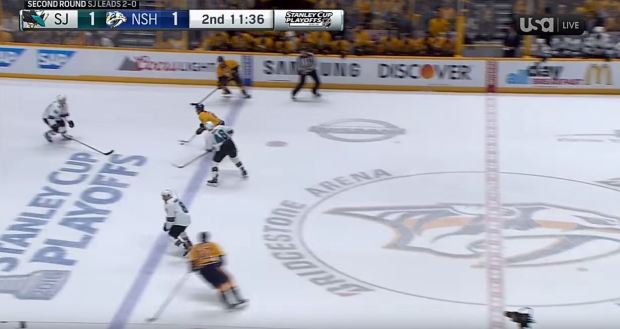
Here we have Nashville’s first line entering the offensive zone on a counter-attack after Filip Forsberg forced a turnover in the neutral zone a few seconds earlier. The Sharks don’t appear to be in too bad of shape, as they have four players back (right defenseman not pictured) and out-number Nashville at the moment.

San Jose starts to get aggressive as the Preds work the play to the boards. They already have Nashville outnumbered and Pavelski is also there to stop any potential play the Preds might try to setup. The only potential danger is the player not pictured (Ryan Johansen), who is the target of the pass being made by Smith in the play here.
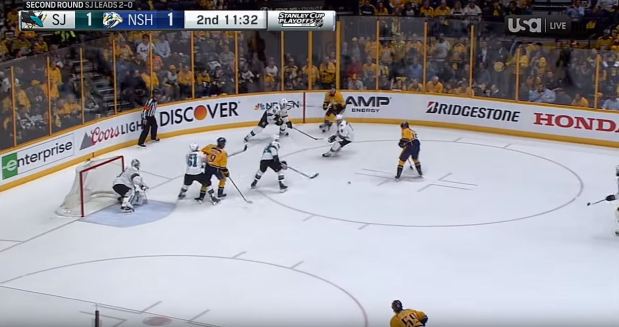
Johansen gets the pass and the Sharks are quick to swarm on him. Meanwhile, Josi starts to creep into the play and Johansen attempts to hit him with a cross-ice pass. You also see Forsberg boxing out Justin Braun in front of the net, creating more room for Josi on the left wing. The Sharks made a gamble by playing this so aggressively and, as you can probably tell by the picture, no one got their stick on the puck so Josi is going to have a very good chance if he receives this cleanly.
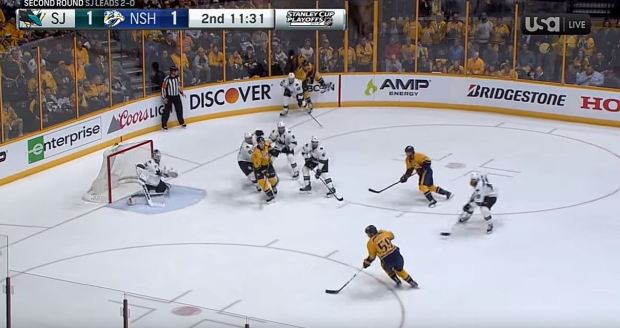
Being a player of his skill, Josi receives Johansen’s pass on the tape and everyone on the Sharks is out of position, so he has goaltender Martin Jones dead to rights.
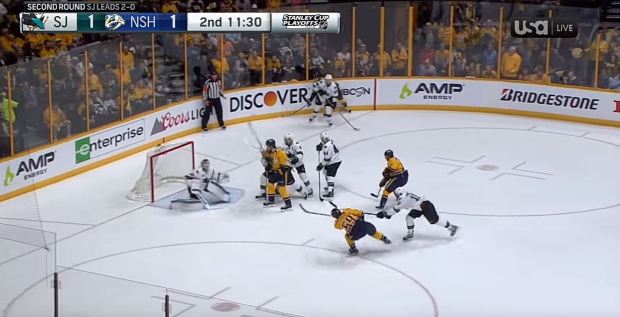
Jones makes the save and San Jose survives this situation, but it could have easily been a lot worse. Josi was uncovered because the Sharks overloaded one side of the ice and Johansen made a fantastic play to make everything come together. San Jose had success at disrupting most of Johansen’s passes this series, so perhaps this was a calculated risk? Either way, this is just one example of the Preds being opportunistic in how they involved their defense. Next we’ll look at play setup by the Wilson-Fisher-Neal line.

The play starts in the neutral zone with Colin Wilson finding Mike Fisher wide open on the left wing. San Jose was a little aggressive in the neutral zone (notice a theme here?), so the Preds were able to catch them out of position here and Fisher has a lot of open ice to set something up.

Fisher takes more of a straight-forward approach, skating down the wing and taking a shot off the once he gets relatively close to the goal. The shot is at a bad enough angle that Jones is able to make a pretty easy save, but his work isn’t done here.
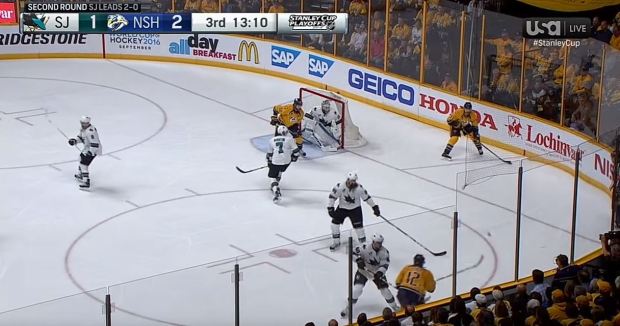
Nashville works a cycle for a couple of seconds with Fisher & Wilson switching places a couple of times in hopes to draw the Sharks out of position again. They also have James Neal going to the front of the net and drawing San Jose defenseman Paul Martin with him.

Things start to open up with Fisher slowly drifting back to the point and taking Tomas Hertl with him. Brent Burns also starts to drift in that direction before reverting his attention back to Wilson, who has the puck in the corner. You would think the objective here is to get the puck to Neal in front of the net, but Martin has him covered pretty well. Wilson can either try a pass or take the puck there himself before Burns gets himself back into position.
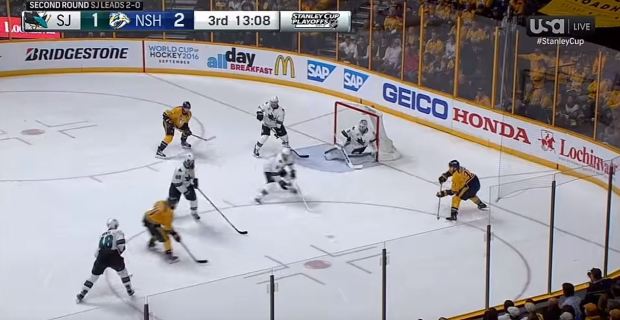
Out of nowhere comes defenseman Ryan Ellis, who Wilson quickly sets up for a potential scoring chance before anyone on the Sharks can react to it. The Sharks appeared to have read this play relatively well. Hertl eventually stopped following Fisher to the point once Ellis pinched, Pavelski is there and so is Burns.
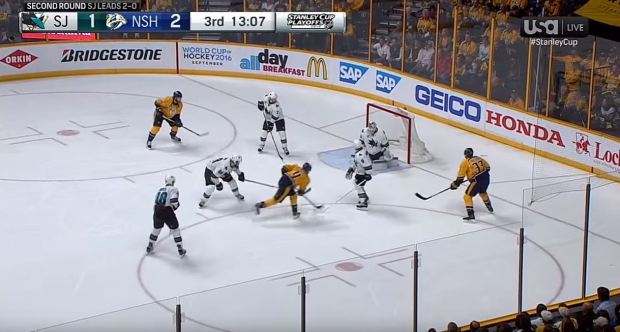
Evidently they weren’t in good enough position because Ellis creates space for himself and gets a good scoring chance on goal because no one on the Sharks could break up the play.
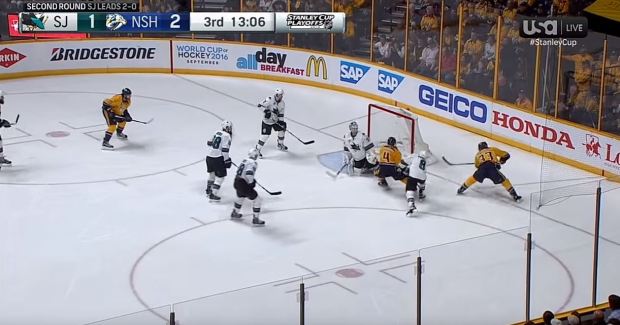
Jones makes the save but gives up a rebound and Wilson quickly pounces on it for an easy goal. Ellis is also there to clean up any garbage if Wilson somehow misses and there’s nothing anyone on the Sharks can do about it. Ellis jumping into the play created some confusion and it looks like no one really knew how to react once he got a shot on goal.
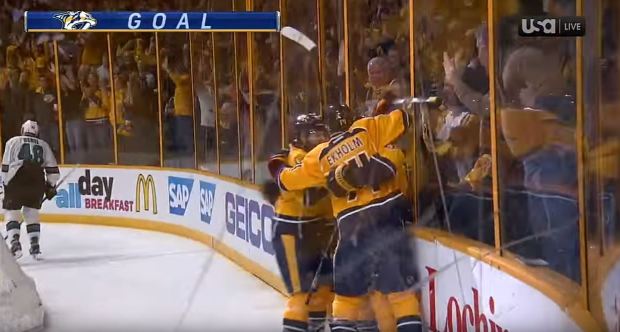
Nashville scores to make it 3-1 and everyone’s happy. Their defense weren’t this active in the offensive zone when it came to making plays on every shift but when there was an opportunity, they took advantage of it and it gave the Sharks trouble all series long.
Nashville had to make some adjustments after losing the first couple of games and it seemed to work for them even if they did ultimately lose the series. Like I said earlier, it was a pretty close matchup despite Game 7 ending up in a blowout.
The Final Word
This was an outstanding series to watch and I really believe that both teams were good enough to win the Western Conference. Nashville just had a bad game at the worst time possible and ran out of gas at the end. San Jose’s a great team with a unique system and it takes a lot to slow them down, as we saw in this series and throughout the playoffs. The Predators came close, though.

Pingback: Under The Microscope: San Jose Sharks vs. St. Louis Blues (Part II: Offensive Zone Play) | The Energy Line